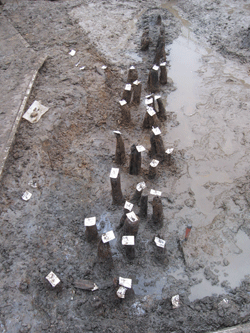
(Courtesy The Museum of London and Pre-Construct Archaeology)
The Olympic Park lies three miles northeast of Londinium (London), the capital of the Roman province of Britannia Superior. During the Roman era (A.D. 43–ca. 410), the area was crossed by a major road connecting Londinium with the town of Camulodunum (modern Colchester). The road, together with the river, would have been a crucial route into Londinium, not least to supply it with agricultural produce. The team dug numerous evaluation trenches, many in dense overlapping arrangements, over the full likely range of the road's course across the valley. But no trace of the road was found, and its precise line across the valley remains an unsolved mystery.
However, archaeologists did find evidence of the Romans exploiting the river landscape, in the form of light timber structures at two locations along its channels, one of which may be a small jetty. "Their Roman date is now certain," reveals post-excavation manager Pippa Bradley of Wessex Archaeology. "The wood from both structures has just been radiocarbon dated to that era," she adds. Roman artifacts were also found, including amphorae and ceramic building material made between A.D. 50 and 160, plus a worn coin of Constantine II (ruled A.D. 337–340)
More London 2012: Archaeology and the Olympics

